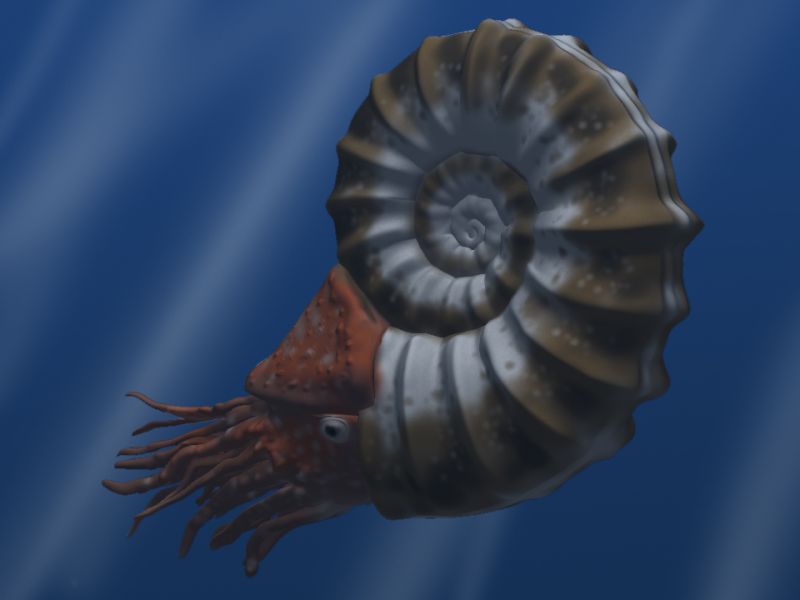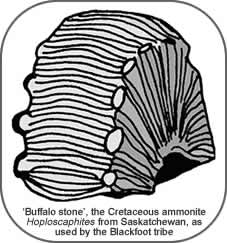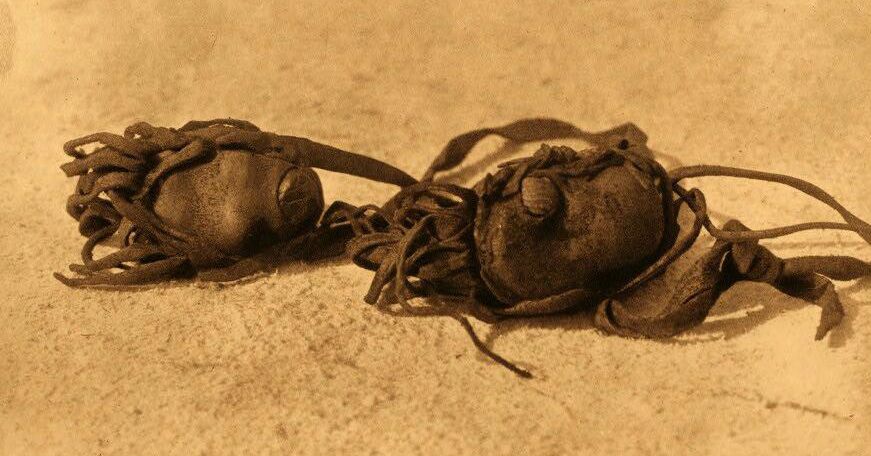Ammonites are the fossils of extinct animals closely related to octopus and squid, for which we find only the shells which generally resemble living seashells like the nautilus. They probably looked like this:

[Artist’s impression of Asteroceras by Arthur Weasley – Creative Commons license]
Some special ammonites were discovered (or discovered by white men at least) in 1908 by a member of the National Geological Survey along the St. Mary's River in Alberta, Canada. Under most circumstances, the fossilized aragonite shells of ammonites convert to calcite, but the conditions of the ancient shoreline in this region preserved them as remineralized and recrystallized aragonite with traces of iron minerals. The ammonites in this area (mainly Placenticeras species) have a very thin coating of bright rainbow-coloured iridescent aragonite like this:

[Placenticeras Ammonite from Alberta – pic from NHM in New York]
The colour is created by interference patterns within the crystal structure of the material. The company Korite International successfully got the material registered as a gemstone (“ammolite”) in 1981 and has commercially mined it since then. It has a price in the region of $50 per carat, despite the fact that it is not quite as unique as the company’s promotional material suggests.
About half of all ammolite deposits are within the Kainah (Kainaiwa) reserve. The Kainai are a First Nation in southern Alberta and one of three nations comprising the Blackfoot Confederacy. The mining operation provides both employment and income, with Korite paying royalties to the tribe based on how much land has been mined.
Blackfeet Legend
There is a particular Native American legend associated with these ammonites, of which there are many versions. The Blackfeet legend tells of a particularly harsh winter during which their food reserves were wiped out by a blizzard. The buffalo herds had moved on, the crops were frozen in the snow and the people were in famine. The Spirits sent a message to a young brave's wife (known as “Weasel Woman”) in the form of a dream. She was given instructions on how to find a brilliantly coloured gemstone with magical properties that would bring a huge herd of buffalo to sustain the people through the winter.
After days of perilous travel, she found the stone hidden in a cave and took it back to her people with instructions on a ceremony that would call the buffalo. The next day everyone was woken up by the earth-quaking sound of stomping hooves and a herd of over twenty buffalo had returned to pasture nearby. The stone has been known ever since as “iniskim” (buffalo calling stone).
I am highly sceptical of the elaborate versions of the legend which specifically link the stone to ammolite, referring to the “sunlight dancing off its rainbow coloured skin” or the woman “marvelling at its brilliance”. In simpler forms, the legend tells more generally that the people began to live as “makoyi” (wolves) but that life was hard and they were often hungry. One day, “iinii” (buffalo) took pity on the people and Weasel Woman found the stone while collecting water from a river near her camp after it called to her from the bushes. The stone told her of a ceremony to be performed to call the buffalo towards a “pisskan” (a buffalo jump).
Other Legends
I suspect that there has been some modern reworking of the legend to make the link more directly to the ammolite gem rather than ammonites in general. The Kainah have another word: “aapoak” (small, crawling stone) which refers generally to ammonites but not specifically to the brightly coloured ammolite variants. Partial pieces of ammonites have associations with several Native American legends about calling the buffalo, bestowing wealth or success and having healing powers and they are frequently reported to be contained in “medicine bundles.”
Mostly, the legends relating to buffalo fall into one of two types. Sometimes they relate to curved and ridged broken sections of the ammonite coil whose appearance may be suggestive of a sleeping buffalo (Kehoe 1965). Like this one:

[pic from London Museum of Natural History]
Sometimes they relate to the eroded sutures which may have four “prongs” that resemble the legs of a buffalo, like this:

[pic from “kodiakdreamer” on the dirttime forum]
The Blackfeet believed that buffalo stones could procreate, a mother stone hatching baby stones (Oakley 1978). One possible explanation for this belief is the tendency for ammonites to fragment along the septa that divide the chambers of the shell. Here’s a sequence of pics which demonstrate that:

According to Grinnel (quoted by Kehoe 1965), buffalo stones are “found on the prairie, and the person who succeeds in obtaining one is regarded as very fortunate. Sometimes a man, who is riding along on the prairie, will hear a peculiar faint chirp, such as a little bird might utter. The sound he knows is made by a buffalo rock... If it is found, there is great rejoicing.”
The Blackfeet historian, Bob Scriver, also documents these stones in his book “Blackfeet”, showing the contents of many very old medicine bundles handed down from generation to generation, and which he purchased in the early 1900s. In many of the bundles were what he calls “Buffalo Calling Rocks”, often wrapped in buffalo fur. According to legend, the buffalo rock was placed inside a rawhide “parfleche” and hung outside the lodge on its own small tripod to call in buffalo.
Here are some examples from the Piegan Blackfeet of Montana:

pic from http://www.firstpeople.us/
The medicine men of the Plains and Navajo Nations also used ammonites and they were known as “wanisugna”, translating to “life within the seed, seed within the shell” (Bassett 1982).
This is another of those areas where, although we know such stones had ceremonial use by certain Native Americans, the stones were selected for their existing shape rather than being modified. As such, any claim for Native use demands context, and that might be some kind of wrapping or – at the very least - perhaps the finding of a stone in an area where ammonite fossils are not known to exist. Otherwise, it’s just a fossil.

[Artist’s impression of Asteroceras by Arthur Weasley – Creative Commons license]
Some special ammonites were discovered (or discovered by white men at least) in 1908 by a member of the National Geological Survey along the St. Mary's River in Alberta, Canada. Under most circumstances, the fossilized aragonite shells of ammonites convert to calcite, but the conditions of the ancient shoreline in this region preserved them as remineralized and recrystallized aragonite with traces of iron minerals. The ammonites in this area (mainly Placenticeras species) have a very thin coating of bright rainbow-coloured iridescent aragonite like this:

[Placenticeras Ammonite from Alberta – pic from NHM in New York]
The colour is created by interference patterns within the crystal structure of the material. The company Korite International successfully got the material registered as a gemstone (“ammolite”) in 1981 and has commercially mined it since then. It has a price in the region of $50 per carat, despite the fact that it is not quite as unique as the company’s promotional material suggests.
About half of all ammolite deposits are within the Kainah (Kainaiwa) reserve. The Kainai are a First Nation in southern Alberta and one of three nations comprising the Blackfoot Confederacy. The mining operation provides both employment and income, with Korite paying royalties to the tribe based on how much land has been mined.
Blackfeet Legend
There is a particular Native American legend associated with these ammonites, of which there are many versions. The Blackfeet legend tells of a particularly harsh winter during which their food reserves were wiped out by a blizzard. The buffalo herds had moved on, the crops were frozen in the snow and the people were in famine. The Spirits sent a message to a young brave's wife (known as “Weasel Woman”) in the form of a dream. She was given instructions on how to find a brilliantly coloured gemstone with magical properties that would bring a huge herd of buffalo to sustain the people through the winter.
After days of perilous travel, she found the stone hidden in a cave and took it back to her people with instructions on a ceremony that would call the buffalo. The next day everyone was woken up by the earth-quaking sound of stomping hooves and a herd of over twenty buffalo had returned to pasture nearby. The stone has been known ever since as “iniskim” (buffalo calling stone).
I am highly sceptical of the elaborate versions of the legend which specifically link the stone to ammolite, referring to the “sunlight dancing off its rainbow coloured skin” or the woman “marvelling at its brilliance”. In simpler forms, the legend tells more generally that the people began to live as “makoyi” (wolves) but that life was hard and they were often hungry. One day, “iinii” (buffalo) took pity on the people and Weasel Woman found the stone while collecting water from a river near her camp after it called to her from the bushes. The stone told her of a ceremony to be performed to call the buffalo towards a “pisskan” (a buffalo jump).
Other Legends
I suspect that there has been some modern reworking of the legend to make the link more directly to the ammolite gem rather than ammonites in general. The Kainah have another word: “aapoak” (small, crawling stone) which refers generally to ammonites but not specifically to the brightly coloured ammolite variants. Partial pieces of ammonites have associations with several Native American legends about calling the buffalo, bestowing wealth or success and having healing powers and they are frequently reported to be contained in “medicine bundles.”
Mostly, the legends relating to buffalo fall into one of two types. Sometimes they relate to curved and ridged broken sections of the ammonite coil whose appearance may be suggestive of a sleeping buffalo (Kehoe 1965). Like this one:

[pic from London Museum of Natural History]
Sometimes they relate to the eroded sutures which may have four “prongs” that resemble the legs of a buffalo, like this:

[pic from “kodiakdreamer” on the dirttime forum]
The Blackfeet believed that buffalo stones could procreate, a mother stone hatching baby stones (Oakley 1978). One possible explanation for this belief is the tendency for ammonites to fragment along the septa that divide the chambers of the shell. Here’s a sequence of pics which demonstrate that:

According to Grinnel (quoted by Kehoe 1965), buffalo stones are “found on the prairie, and the person who succeeds in obtaining one is regarded as very fortunate. Sometimes a man, who is riding along on the prairie, will hear a peculiar faint chirp, such as a little bird might utter. The sound he knows is made by a buffalo rock... If it is found, there is great rejoicing.”
The Blackfeet historian, Bob Scriver, also documents these stones in his book “Blackfeet”, showing the contents of many very old medicine bundles handed down from generation to generation, and which he purchased in the early 1900s. In many of the bundles were what he calls “Buffalo Calling Rocks”, often wrapped in buffalo fur. According to legend, the buffalo rock was placed inside a rawhide “parfleche” and hung outside the lodge on its own small tripod to call in buffalo.
Here are some examples from the Piegan Blackfeet of Montana:

pic from http://www.firstpeople.us/
The medicine men of the Plains and Navajo Nations also used ammonites and they were known as “wanisugna”, translating to “life within the seed, seed within the shell” (Bassett 1982).
This is another of those areas where, although we know such stones had ceremonial use by certain Native Americans, the stones were selected for their existing shape rather than being modified. As such, any claim for Native use demands context, and that might be some kind of wrapping or – at the very least - perhaps the finding of a stone in an area where ammonite fossils are not known to exist. Otherwise, it’s just a fossil.